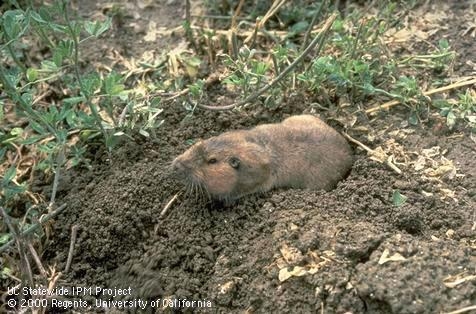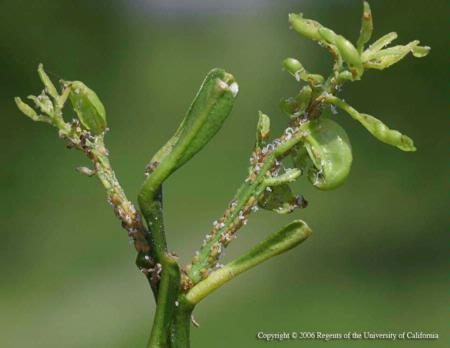- Author: Ben Faber
Trying to stay abreast of the insect and disease it carries to citrus? The Ventura County Farm Bureau and Ventura County ACP-HLB Task Force have put together links and a Facebook page that have all the latest breaking news concerning the threat to California’s citrus industry and to the iconic backyard tree.
This is one of the best ways to find out how this pest/disease complex is being dealt with.
- Author: Chris M. Webb
Research to fight Huanglongbing (HLB), the deadly citrus disease carried by the Asian citrus psyllid, is taking place throughout our nation and the world. Industry-wide urgency is funding a variety of research in search of a solution.
In 2010 a National Academy of Sciences panel concluded that genetic engineering “holds the greatest hope”. A promising genetic engineering study, developed by a scientist at Texas A&M's Texas AgriLife Research and Extension Center is moving into the field testing stage.
Using spinach defensin proteins to help protect citrus trees and then exposing the trees to the bacterium, lab and greenhouse studies show infection rates are very low even when the trees are exposed to higher concentrations of infected insects then would be found in a commercial grove. The type of defensing protein used in the study can be found in plants, insects and mammals.
To learn more please see the AP article, Spinach could be weapon against citrus scourge.
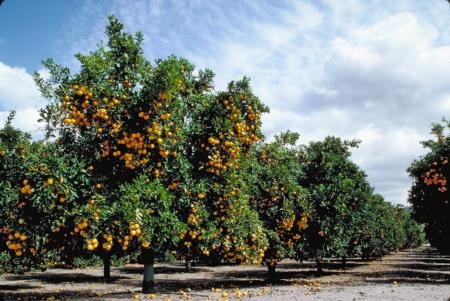
- Author: Tracy L. Kahn, Department of Botany and Plant Sciences, University of California, Riverside
Since 1910, the Citrus Variety Collection has been a resource for research, citrus breeding and educational extension activities initially for the UC Citrus Experiment Station and now for the expanded College of Natural and Agricultural Sciences at UC Riverside. As one of the most diverse collections of citrus varieties and related types in the world, this collection currently has three locations, the central collection is at UC Riverside and two smaller collections of citrus relatives are at South Coast Research and Extension Center in Irvine, CA and the Coachella Valley Agricultural Station in Thermal, CA. The collection consists of approximately 1,800 trees representing two trees of each of the 900 different types of citrus and citrus relatives. Approximately 640 of the types are within the sub-genus Citrus. Most commercial citrus varieties such as the different mandarin varieties are classified botanically in the sub-genus Citrus of the genus Citrus. The collection has approximately 170 different mandarin and mandarin hybrid types including 14 Clementine selections, W. Murcott Afourer, and the UCR developed mandarin hybrids Gold Nugget and the Shasta Gold™, Tahoe Gold™ and Yosemite Gold™ mandarin hybrids. Commercial types that are exceptions to this include the kumquats, which are in the genus Fortunella and the Trifoliate oranges commonly used as a rootstocks or as parents for hybrids which are in the genus and species Poncirus trifoliata. The genera Fortunella and Poncirus as well as the 30 other genera related to the genus Citrus are classified within the subfamily Aurantiodeae of the Rutaceae plant family. The UC Riverside Citrus Variety Collection has 900 types within 28 of the 33 genera of the subfamily Aurantiodeae of the Rutaceae.
The Citrus Variety Collection has varieties that were incorporated into the collection in the early 1900s and newer varieties that were recently imported into California from other parts of the world through the efforts of the UC Citrus Clonal Protection Program . The diversity in the collection is apparent visually by types with fruits of unusual shapes, sizes, colors, and tastes growing on trees of varying heights, forms, and foliage characteristics. There are types with fruit as big as one’s head and ones as small as a green pea. This living collection also produces fruit with variation in the chemical compounds of the rind and flesh noticeable by the great differences in tastes, textures, and aromas. One type that has recently received attention is the Australian Fingerlime or Microcitrus australasica which has fruit flesh composed of small round juice vesicles that look like caviar and have a flavor and aroma reminiscent of lime. Underlying all of this visible and tangible diversity is genetic diversity which can and has been manipulated, combined, and transferred for the improvement of citrus crops for productivity, taste, and disease and environmental tolerance or resistance and the development of new food and horticultural crops.
The range of diversity within this collection makes it a valuable resource for research for the California Citrus Industry. Currently, the collection serves as a genetic resource for an array of research projects conducted by researchers from UC Riverside and other Universities which range from scion and rootstock breeding for the improvement of commercial varieties to the study of the biological activities of citrus limonoids as anticancer agents. Since 1997 over 40 different projects have utilized trees in the Citrus Variety Collection. The USDA-ARS National Clonal Germplasm Repository for Citrus and Dates (NCGRCD) in Riverside situated adjacent to the collection, uses the Citrus Variety Collection as its field site to help fulfill its mission to acquire, preserve, distribute, and evaluate genetic diversity within Citrus, and the 32 related Aurantioideae genera.
The Citrus Variety Collection also serves as a resource for many extension activities. California citrus growers, nursery owners, and other industry representatives, as well as students and teachers from local public schools, the University of California, and the California State College campuses visit the collection to evaluate potential commercial citrus varieties and learn about citrus diversity. In addition to tours, the staff of the Citrus Variety Collection provides fruit displays and oral presentations on the performance of various citrus cultivars at CRB and UC Cooperative Extension sponsored growers meetings, at the Sunkist Annual Meeting, the World Ag Expo, and the Orange Blossom Festival in Riverside CA. The various fruit displays and the citrus tasting at the Riverside Orange Blossom Festival which is visited by thousands each year, is picked from the collection.
In March 2003, the Advisory Committee for the Citrus Variety Collection established an endowment fund. The goal for the endowment fund is to be the primary source of financial support for the maintenance and activities of the Citrus Variety Collection. The goal is that the portion of the endowment fund will in the future provide major support for the maintenance and activities of the Citrus Variety Collection as state funds become more limited. If you would like to know more about the Citrus Variety Collection or learn how you can help support the collection, contact Dr. Tracy L. Kahn or (951-827-7360 or visit the Citrus Variety Collection web site.
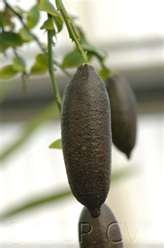
- Author: Ben Faber
Irrigation efficiency requires not only uniform irrigation, but also the proper timing and amount of applied water. It is important that the irrigator know the system water application rate, either in inches per day, inches per hour, or gallons per hour.
Irrigation scheduling which determines the time and amount of water to be applied can be accomplished through a variety of methods, including measuring soil moisture, determining plant moisture status and determining evapotranspirational loss (ET crop or ETc). Evapotranspiration values are a measure of the actual amount of water well watered plants would use. This information is available in many areas of California from newspapers, irrigation districts, and over the Department of Water Resources CIMIS network California Irrigation Management Information System, or CIMIS Help Line (800) 922-4647).
Evapotranspiration varies seasonally and from year to year for a given location. DWR has developed a map of the average daily ET for various zones in California. These zones are distinctive because total sunlight, wind, relative humidity and temperature are the parameters that drive water loss and differ in each zone. Where the Central Valley becomes hot and cloudless in the summer, along the coast the intensity of the marine layer and its effect on sunshine differs from year to year.
Scheduling, as opposed to a fixed amount applied at a fixed time, is especially important in Southern California coastal valleys. Although the average annual irrigation requirement is about 2 feet of applied water per year (2 acre-feet per acre or 651,702 gallons per acre), this value varies tremendously from year to year, from as little as 18 inches to as much as 3 feet.
One of the most important variables in the quantity of applied water is the length of the rainfall season and the effectiveness of the rainfall. The rainfall season determines the length of the irrigation season and effective rainfall determines how much the plant can use. Effective rainfall is defined as the amount of rainfall, which is retained in the root zone of the tree. For example, consider a rooting depth of 2 feet and each foot holds 1 inch of available water. If you have just irrigated or if it rained 2 inches yesterday and it rains 2 inches today, none of today's rain is effective since the soil was already moist. It did leach salts out, however. Rain events of less than 0.25 inches are also not considered effective.
Determining an irrigation schedule based on tree water requirement falls into three broad categories of technology - plantbased, soil-based and weather-based. Many of these technologies are proven and have been in use for years. Others are more experimental and have not been fully tested. In several cases improved electronics and digitalization have put a new spin on older technologies. A method of determining when to irrigate should be learned by all growers and often a combination of techniques can be employed.
Plant-based Scheduling Methods
The plant is the ideal subject to measure, since it is integrating all the various factors driving water loss as well as soil moisture and any stresses such as soil salinity and plant health. To be a useful tool in irrigation scheduling, plant-based measuring devices must provide indicators of stress before that stress reaches levels that result in yield decreases. The methods include:
- Pressure chamber (pressure bomb or Schollander pressure chamber) measures plant water tension by applying a comparable air pressure to a leaf or stem. The amount of pressure required to equilibrate with the plant sap indicates how much stress the plant is under.
- Trunk diameter fluctuations (shrink/swell), measured continuously with linear variable displacement transducers (LVDTs), can be used to calculate parameters that are directly related to tree stress.
- Stem flow gauge estimates transpiration by placing a heat source on the trunk of the tree and then measuring the temperature differential along a trunk.
- Porometer measures the ability of a leaf to transpire, so when the leaf is under water stress then less water is transpired.
- Infrared thermometry measures the canopy temperature as affected by the rate of transpiration, so as the plant goes under water stress, the leaves gets warmer.
- Visual symptoms (wilting, leaf curling) are the cheapest method, but the most expensive in the long run.
- While these techniques can be valuable for scientific use, there has been little adoption in commercial agriculture. With the exception of the pressure chamber and LVDTs, this is due to the aforementioned problem of being able to identify mild water stress. Another reason for their lack of use by commercial agriculture, specifically subtropicals, is that there are logistical problems with mature trees, such as with the stem flow gauge and infrared thermometry. At this time, the pressure chamber is the state of the art in measuring tree water stress in subtropicals while recent research indicates that the LVDTs show promise for automating irrigation scheduling.
Soil-based Scheduling Methods
A rule of thumb is that irrigation timing should occur when about 50% of the water available to the plant has been depleted from the soil. The 50% figure is arbitrary; it allows a buffer of water in the soil in case the weather suddenly turns hot and windy.
Of course a sandy soil will hold less water than a clay soil, so irrigation will be more frequent. A common perception is that it takes more water to grow plants in sandy soil than clay soil. The total amount required for the whole year by the tree will not be changed by the soil type. This is because it is the sun, wind, temperature and humidity, which decides how much water the tree, will need. The soil is only the reservoir.
To check the water content in the soil, take a trowel, shovel, or soil tube and dig down 8 to 16 inches. A soil that has about 50% available water remaining will feel as follows:
Soil texture
- coarse - appears almost dry, will form a ball that does not hold shape;
- loamy - forms a ball, somewhat moldable, will form a weak ribbon when squeezed between fingers, dark color;
- clayey - forms a good ball, makes a ribbon an inch or so long, dark color, slightly sticky.
Irrigation timing can be determined and also mechanized with the use of a tensiometer. These water filled tubes with a pressure gauge accurately reflect the amount of energy a plant needs to extract water from the soil. The pressure gauge measures "tension values" in centibar units (cbars). When the gauge reads 30 cbars, it is a good time to irrigate.
Placement of the tensiometers requires that they be within the root zone, between the emitter and the tree trunk. Having two tensiometers next to each can be helpful in deciding both when to turn the system on and when to turn it off. A tensiometer at a one-foot depth tells when the water should be turned on and a tensiometer at three feet tells when to turn the system off. Placing a plastic milk crate over the device will prevent pickers from kicking them over.
There are other devices on the market for measuring soil moisture. Gypsum blocks are very effective. Although the part in the ground is inexpensive, the reading device costs in the $250 range. This cost means a large enough acreage is required to spread out the cost of the system.
There are portable meters on the market for measuring soil moisture. These meters rely on an electrical current carried by water in the soil. Even the cheap $10 ones can give a rough estimate of the soil water content. None are very effective in rocky ground, because their sensitive tips break easily.
The amount of water to apply at an irrigation depends on the amount of water held within the root zone. A loamy soil where a microsprinkler with a 20-foot diameter throw has wetted a twofoot depth will hold about 200 gallons of water at 50% of the soils water holding capacity. Exceeding this amount of water will help leach salts; but if far in excess, additional water is only pushing existing water out of the root zone.
It is best to follow one or two irrigation cycles to find out how long to run the system to achieve a certain depth of infiltration. This can be done with a shovel or more easily with a pointed rod or tensiometers. Water moves in a wetting front, and the wetted soil will allow the rod to be pushed in to the depth of dry soil. The system should be run to find out how long it takes water to infiltrate to a depth of two and three feet. That information will indicate how long to run the system when irrigating.
Applying water to achieve a two to three foot depth may take several hours. If run-off occurs, the system may be turned off for a few hours, then turned on again to get the total run time required to infiltrate to a given depth. If run-off is severe, use emitters with a smaller flow rate.
Soil-based methods monitor some aspect of soil moisture which, depending on the method, requires some correlation to plant water use. Some of the methods are well understood and inexpensive, others are expensive, inaccurate, inappropriate or not well researched. Some of the techniques allow multiple site readings while others require a device to be left in place. Some measure soil water directly, like oven-drying and others measure some other parameter with is associated with water content, such as electrical conductance. Some are affected by salts or soil iron content and others have limited value in the desired soil moisture range. Some, like tensiometers and gypsum blocks, give a reading from a porous material, which comes to equilibrium with soil moisture, while many others use the soil directly as the measured media. This is an important distinction since discontinuities in the soil caused by rocks or gopher holes can affect readings when the soil is used to carry a signal. Also, times have changed and some of the old techniques have been improved. For example, gravimetric oven-drying can now be done by microwave, considerably speeding up the process. Tensiometers and gypsum blocks can now be found with digital readouts and connections to data loggers, which make data easier to manage. There are quite a number of devices on the market and the following chart will shed some light on their differences.
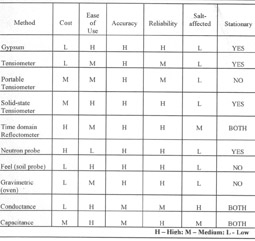
As with any tool, the value of these devices increases with use and familiarity. Even though several of these are listed as stationary devices, by placing them in representative positions in the orchard, they can accurately reflect the rest of the orchard. Several of the devices are listed in the table as being both stationary and portable; this is because there are various models that can act one way or the other. The "Ease of Use" category in the table indicates not just the ease of reading the device, but also the maintenance required for it.
Weather-based Methods of Irrigation Scheduling
Another scheduling technique that has become popular is the use of weather data that has been converted to a crop water use value. This value is the estimated amount of water an orchard would use. The value is often referred to as the evapotranspiration (ET) of the crop. ET is the amount of water that can be lost by a well-watered crop either through the leaves (transpiration) or evaporation from the surface of the soil. By applying the ET amount at an irrigation, the trees are kept at optimum moisture content. The technique is often called the water budget method or checkbook scheduling.
The CIMIS network of over 50 weather stations calculates reference evapotranspiration (ETo). This value is an estimate of the amount of water lost from a well-watered field of grass. Grass is the standard or reference for all other crops. ETo is modified for the specific crop with a crop coefficient (kc). The formula for converting ETo to crop ET is: ETo X kc = ETcrop.
For a full-grown subtropical orchard a kc of 0.65 is used in most of the State, but in the desert growing areas, 0.56 is used. With smaller trees, a smaller kc is used. When trees are young and intercept little energy to drive water loss, a kc of 0.05 works well. As the trees increase in size to where their shade covers about 65% the soil surface, the kc is gradually increased each year. With rapidly growing trees, the kc increase is usually about 10 % each year, until about year 8 when the 65% figure is reached. A correction factor needs to be incorporated for the irrigation system distribution uniformity, as well.
If the orchard is cover cropped for part or all of the year, the period during which the cover is present needs to be recognized in the water use calculation. A soil that is covered by a cover crop and trees uses water just like a mature orchard. Therefore, if the young orchard is covered by a perennial cover crop a kc of 0.65 is used regardless of tree size. If a winter annual cover is used, that uses only rainfall for its growth, correction is not usually necessary in a high rainfall year. But in low rainfall years, the water requirements of the cover need to be recognized in the irrigation program.
Reference evapotranspiration values are available from many irrigation districts, CIMIS, several weekly journals and magazines. In Ventura County, the values are available through County Flood Control, and in San Diego County, they are available from the Resource Conservation Districts.
One of the drawbacks of the centralized weather stations is that in hilly terrain with different sun exposures, the station values can be quite different from the water loss at a grove. When using evapotranspiration figures it is always important to back up the estimates with field checks in the grove. An alternative to using the centralized weather stations is establishing one of your own. These electronic stations cost in the range of $5,000 and require regular maintenance as well.
A simpler weather station can be developed with an evaporation pan or an atmometer (atmosphere meter). Both of these devices actually measure the loss of water due to evaporation and since the physics of evaporation and transpiration are very similar, the values can easily be used in a water budget.
The major drawback to the evaporation pan is the maintenance required to keep birds, coyotes, and bees from causing inaccurate readings. Algae also needs to be kept free of the pool. An atmometer is a closed system with a ceramic head, much like a tensiometer. As water is drawn out of a reservoir, a sight tube shows how much water has been evaporated. The atmometer is more expensive (~$300) than a pan, but it is much easier to maintain.
Regardless of what scheduling technique or combination of techniques is used, a thorough evaluation of the system needs to be performed so that a known amount of water is being applied. Until volume and distribution of water are known, it makes little sense to schedule applications.
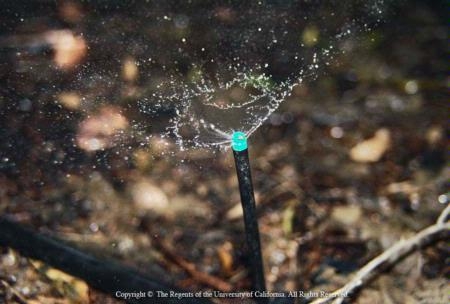
- Author: Mark Freeman
Vertebrate pests that have caused damage to citrus trees include rodents and small mammals, large mammals, and birds. Citrus orchards provide food and shelter for a number of these pests, and damage may be severe if the pest resides in the orchard. Damage can occur to the fruit such as rat chewing or bird droppings. Bark damage and tree death can occur from rodents and larger mammals. Damage to irrigation systems such as chewing on hoses can easily be the most expensive damage.
The goals of a successful management program include reducing the number of pest problems and using control methods that are affordable. There are four key points to establishing and maintaining a vertebrate pest management program. First, one must identify the specific damaging species. Second, review all the management control options. Third, one must take action quickly and early, and use the best option that is appropriate for the time of year and the orchard. Fourth, use a monitoring system to detect when re-infestation occurs and thus more controls are needed.
The first key point is identification and observation. Many of the agricultural commissioners’ offices in the counties can help with this problem. In addition, University of California Production Manuals such as almond and walnut have reference material on different pests. It is critical to identify the specific species or type of pest causing damage. You can use direct observations with some pests such as birds or squirrels that are active during the day. With pests that are active at night or tend to hide, one looks for tracks, burrows, or the type of feeding; or one can use traps. With rodents, one can use the size of the incisor marks on plants to help identify the pest. This is also useful on irrigation systems, where one can remove the damaged part and take it to an expert. Traps are also used where trails are established to capture and identify the pest. Pictures, especially close-ups are very useful and can be emailed or sent to experts on the Internet. If you also describe the adjacent habitat such as foothills, streams or rivers, etc., that information will help.
For some pests, there are many possible control options. It is very important to check with the agricultural commissioner’s office as animals vary by protected status and how the animal can be legally controlled. The pest’s life cycle will determine when and if a certain control method can be used. For example, ground squirrels can be controlled effectively with poisoned baits but not in early spring when the animal is feeding on green material. Gophers can be controlled all year with poisoned baits that are applied into the burrows, but are more active when the soil is moist. Habitat modification may be an economical option, as brush piles near an orchard will provide shelter for pests. Biological control such as attracting owls and hawks to an orchard can assist with control, but seldom keeps rodent levels below economic levels.
It is important to act quickly when a control measure is selected. Some vertebrate pests can increase in population quickly, and control is less expensive with lower numbers of pests. Some pests will reside in the orchard, and create a home there. It is much easier to control them when the pests live outside the orchard.
Finally, it is important to have a monitoring system in place after controlling a vertebrate pest so as to detect if the pest is re-entering the orchard. A good record system is important.
Many of the citrus orchards in the San Joaquin Valley (SJV) are located near the foothills on the eastern side. Some of the more common vertebrate pests include gophers, ground and tree squirrels, mice, rats, rabbit, coyote, feral (wild) hogs, and starlings. Rare tree damage has occurred from bear and beaver. There is more new acreage in the SJV planted in the middle of the valley. Those trees will be susceptible to the vertebrate pests already found nearby.
Rodents such as gophers and meadow mice (or voles) feed on plant roots, and can girdle and kill young citrus trees. Occasionally, gophers can kill mature trees, especially if the tree is weakened by other factors such as root rot. Many members of the rat family and deer mice will feed on citrus fruit. The effectiveness of control measures depends on identifying the specific rodent. The Eastern Fox Squirrel (EFS) is a tree squirrel found near big cities in the SJV and throughout the metropolitan areas of Southern California. It has moved to adjacent commercial citrus orchards and will feed on ripe fruit.
Coyotes, rabbits, and squirrels will damage irrigation hoses. By examining the damage, experts can identify the pest. The EFS has caused considerable damage to irrigation systems in some nut crop orchards in the Fresno area.
Larger mammals can be economic pests. Wild hogs will feed on fruit, damage bark, and create large holes or “wallows” on the orchard floor where it is moist. Occasionally, hogs will destroy irrigation hoses. Beavers have destroyed young citrus trees located near streams.
Bird problems have occurred mainly due to large flocks of starlings that nested in orchards at night. The damage resulted from the bird droppings on the fruit.
More information about vertebrate pests can be found here.
